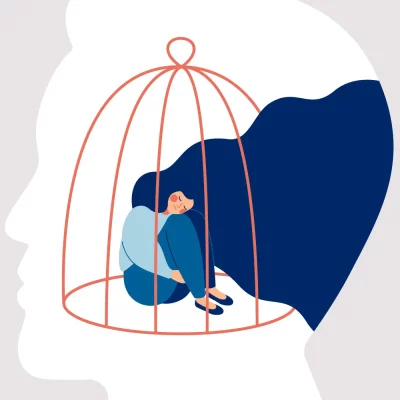Do you feel like your needs and wants are always put on the back burner while those of your partner come first? Do you feel like it is hard to be yourself around them, or that they are constantly trying to control or manipulate you into doing what they want?
If so, then you might be in a codependent relationship. It can be difficult to recognize these patterns on our own, but understanding the signs of codependency could help us identify if we’re in an unhealthy relationship.
The term codependency was first introduced in the 1980’s specifically identifying behaviors between people with substance abuse issues and those who were in relationships with them. Since the mid 1980’s, the term has a much broader definition that applies beyond the presence of chemical addictions.
It’s important to note that this post will reference codependent relationships in the realm of romantic relationships, but this can exist in any relationship. Whether family members, friends, coworkers or a boss, codependent behavior can negatively affect your life. Identifying this type of relationship uses the same information, so feel free to adjust wording to make it apply to your situation.
This post breaks down what codependency is, what interdependence is, how to identify a codependent person in relationships, and how to move toward interdependence to grow into a more healthy relationship for each person. Read on to learn more!
Signs of a Codependent Relationship
Codependency is an unhealthy relationship dynamic in which the needs of one person are prioritized over those of their partner.
Common signs of a codependent relationship include:
- Lack of boundaries or sense of self
- Difficulty expressing opinions or emotions
- Difficulty saying “no”
- Overly passive behavior
- Low self esteem
- Feeling the need to be constantly needed
- Difficultly expressing love outside the relationship
- One person’s needs being prioritized over the other partner’s
Additionally, codependent people may be overly passive, suffer from low self-esteem, feel a need to be constantly needed, avoid conflict, and have difficulty expressing love outside of the relationship.
It is important to recognize that the signs of a codependent relationship do not necessarily mean that someone is in a codependent relationship. It is possible for people involved in healthy and supportive relationships to exhibit some of the symptoms, such as difficulty expressing emotions and opinions, difficulty saying “no”, or being overly passive. It may be necessary these issues gently and with an open mind.
Also worth noting is that codependent behavior can be an adaptive coping mechanism that can start as early as childhood. Focusing on another person’s needs while ignoring or downplaying your own feelings is a defense mechanism.
For example, codependent people tend to think if they are loved (by taking care of others’ needs) then they are lovable. Sometimes codependency can be an incredibly manipulative experience. Other times, codependency is simply a learned way to survive.
Understanding Interdependence
Interdependence is a healthy alternative to codependency. It is an important concept that emphasizes mutual reliance and respect between two individuals in a relationship, instead of one dependent person relying solely on the other.
Traits of an interdependent relationship include:
Respecting individual boundaries:
Each partner values their own identity and independence and respects the other’s autonomy.
Mutual supportiveness:
Both parties feel supported by the other partner and make efforts to support each other through listening, understanding, empathy, and problem solving.
Equality:
There is parity in decision making within the relationship without one partner having more power than another.
Open communication:
Partners communicate openly about feelings as well as practical matters such as finances or parenting decisions; conversations focus on solutions rather than blame or criticism.
Flexibility:
Couples demonstrate willingness to be flexible for each other while remaining true to who they are individually; this can involve compromise when needed but also allows for personal growth outside of the relationship
Codependent relationships are built on a lack of boundaries, low self-esteem, and enabling unhealthy behavior. In contrast, interdependent, healthy relationships are built on trust, communication, and shared responsibility.
Identifying Codependent Relationships
Once we understand the signs of codependent relationships, we can begin to self-reflect and observe patterns of behavior in our own relationships. Through these activities, we can start to identify if we are in a codependent relationship.
One way to identify a codependent relationship is through examining how you interact with your partner.
Look for signs such as:
- Trying to control or manipulate your partner
- Feeling like you need to be constantly needed
- Fearing abandonment if your partner leaves or expresses disagreement
- Giving too much without receiving anything in return
- Not feeling comfortable expressing yourself fully
Another way to identify a codependent relationship is to look at how your partner interacts with you.
Do they:
- Attempt to control or manipulate your behavior?
- Act overly needy or dependent on you?
- Criticize, belittle, or invalidate your feelings and opinions?
- Get angry if you don’t fulfill their needs or wants?
- Try to make decisions for both of you without consulting you first?
These are all signs that the relationship may include codependent behavior.
Recognizing codependency in a relationship can be very challenging, as codependent behaviors and dynamics can easily become normalized and internalized. It is hard to break old patterns of behavior that have been established over time, and it can be difficult to admit that our own needs and feelings are not being taken into account. It is also common for those in a codependent relationship to feel like they cannot leave, out of fear, guilt, or obligation.
Each relationship is different, so it’s important that if you feel afraid to bring this up to your partner, or fear for your safety, its important to seek support from a therapist or trusted family member or friend.
Growing Towards Interdependence
Moving from a codependent to an interdependent relationship can be difficult, but it is completely possible. It requires both partners to be willing to break unhealthy habits, communicate openly and honestly, and commit to making the necessary changes for both of them.
Here are some actionable steps individuals in codependent relationships can take to grow towards interdependence:
1. Prioritize self-care:
Take time for yourself and focus on rebuilding your sense of self and self confidence. This will help you become more independent and better able to express your needs to your partner.
2. Practice communication:
Open up about how you are feeling in the relationship, without fear or guilt. Be honest with yourself, and take responsibility for your own feelings and actions.
3. Respect boundaries:
Work to create and maintain healthy boundaries within the relationship, such as respecting each other’s space and time to be alone or with friends.
4. Develop mutual understanding:
Embrace the differences that arise between you both, and use these as opportunities to learn from each other rather than trying to fix them.
5. Set achievable goals:
Work together to set realistic and attainable goals for yourselves as individuals, and as a couple. This can help create mutual respect and understanding between you both.
Breaking free from codependent relationships is not easy, but it is possible when both partners are willing to work on the relationship together. It requires communication, self-awareness, patience and understanding. With these skills, and the right attitude, a relationship can move away from codependency towards interdependence. This will lead to a healthier, more balanced dynamic that is beneficial for both partners within the relationship.
Conclusion
Growth is a process, and it’s important for those in codependent relationships to understand that small steps can lead to big changes. By taking the time to recognize and assess your own emotions and relationship dynamics, you can identify if you are in a codependent relationship and begin to make positive changes towards interdependence.
It can be intimidating and overwhelming to face these issues, but with the right tools and support, progress can be made. With time, self-reflection, and open communication, codependent relationships can move towards a more balanced interdependent relationship.
If you need help during this process, we offer individual and couple’s counseling, depending on your needs, to help walk you through issues that keep you from the healthier relationship you want.
We offer a range of types of therapy, such as in person and tele-health sessions, that make it possible to benefit from therapy even when you have a busy schedule. Don’t hesitate to give us a call or make an appointment to get the healing journey started today!








